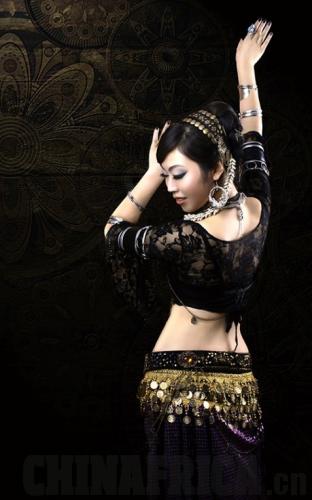| 
How did you first start belly dancing?
At first, I did it to lose weight. But my mind had always been filled with fantasies about this mysterious country, Egypt. So in the following years, the more I learned about belly dancing, the more obsessed I became with it and with Egyptian culture as well.
For further study, I went to Cairo in 2009 where I luckily met my idols – masters like Mahmoud Reda, Diana Tarkhan and Khaled Mahmoud. Everyday I practiced for six to nine hours. It was hard but worth it. I was taught not only the dance itself but also ways to go about demonstrating the charm of Eastern dances. I wish to share these with dance lovers in China.
What inspired you to create this dance drama?
In Daughter of the Nile, I integrate my childhood memories with what I learned in Egypt. It recalls girlhood. As a leading belly dancer in China, I feel responsible to promote traditional belly dancing. But it's also important to add new elements since belly dancing also embraces cultures around the rest of the world.
Is there any difference between belly dancing in China and in Egypt?
Without a standardized learning system, there have been many misunderstandings about belly dance education. In China, belly dancing is an emerging industry. The dancers who take it up as a career are eager for quick success. They wish to master it in the shortest amount of time and with the least amount of effort. That's impossible. Egyptians begin dancing it as children. It takes them decades to make progress. Even for a genius, a couple of days' course is just an introduction. To be a belly dance teacher takes time – time to accumulate experiences and artistic accomplishment.
Belly dancing in China is seen as a form of physical training, but it exists in the blood of Egyptians. They express their heart and soul through dancing. During my three years in Egypt, I spent several hours every day watching videos of international masters. The dances of an Egyptian master, to me, represent what "real" dance is. Your heart follows her, and your body hopes to move along with her. I may not understand the lyrics of the dance's music, but I can catch their meaning through the dance. Dance is in Egyptians' blood, which makes their performances skillful and touching.
Do you think belly dancing can gain popularity in China?
It's great that Egyptians have guarded this cultural heritage for 3,000 years. And as a promoter of belly dancing in China, I have a long way to go. It has been only seven years since belly dancing was first introduced in China in 2005. At the time, people had misconceptions like, "It's a sensual dance," or "It's only for young people." But now, more and more Chinese are embracing it as a healthy activity. Belly dancing lovers include office ladies, students and even elderly people.
What are your plans for future?
This year, I am hoping to join Belly Dancer Evolution, the world's top belly dancing group, to showcase traditional Egyptian dance with a Chinese face on an international platform. I love belly dancing, so I will try my best to promote it in order to have this 3,000-year-old dance appreciated by more people. |